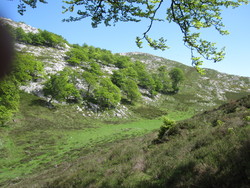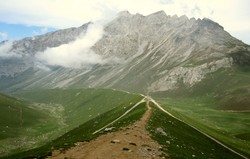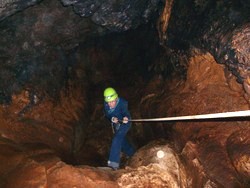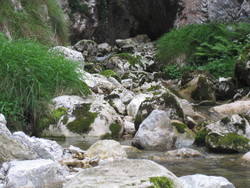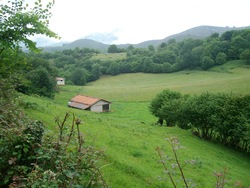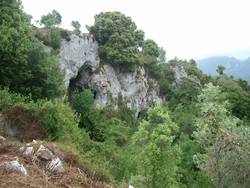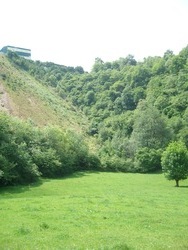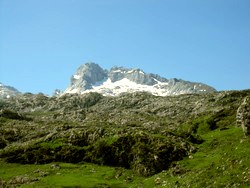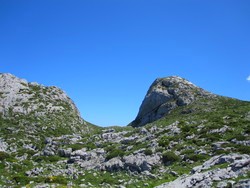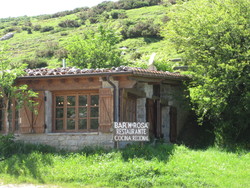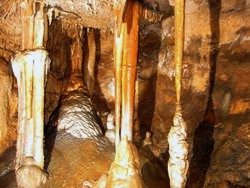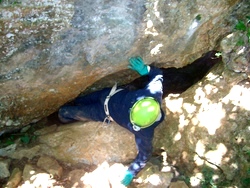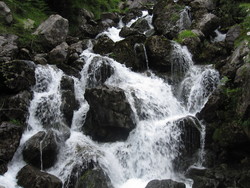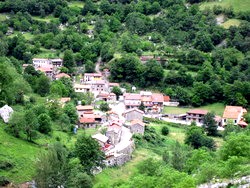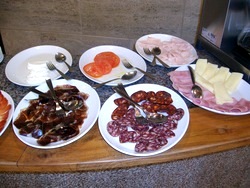

Introduction
Site list (GPS fixes) Walks (GPS tracks) Video clips Panoramas
Electronic projects:
Bat detector
Lamp tests
µ-controlled lamp
SEPIC-based lamp
ISP isolators
Making SMT boards
Expedition logs:
Spain 1973, 1974,
1975, 1976, 1977,
1979, 1982, 1983,
1985, 1986, 1987,
1988, 1989, 2000,
2001, 2002, 2003,
2004, 2005, 2006,
2007, 2008, 2009,
2010, 2011, 2012,
2013, 2014, 2015,
2016, 2017, 2018,
2019, 2020, 2021,
2022, 2023
Mexico
New England
Translation:
Expedition log, Summer 2011
Áliva, Cofría, Avín, Tenis, Dobros, Forcau, Llonín, Caín.
| Date | Activity |
|---|---|
| 16.05 | Bill gets up at 6, and drives to Asti station to catch the 7:13 train for Pisa Airport, changing at Genoa and Pisa. Take-off delayed by half an hour and although the pilot made a good attempt to recuperate the lost time, we lost our slot at Santander and circled above the runway waiting to land. Fortunately Bill’s bag is the first off the plane and there’s no passport control. So within 10 minutes of landing Speleogroup is reunited at the Hertz desk, Mike having arrived from Stansted a few minutes earlier.
Mike drives the diesel Opel west and we stop briefly in San Vicente for a refreshment; then on to Montemar in Llanes. Later, as old customers, we were recognized in the Uría restaurant close to the harbour bridge. Meat and potato stew followed by merluza a la romana for Bill and escalope for Mike. |
| 17.05 | Sunny day so off to the Sotres → Tresviso road for a walking trip
based on the “cross roads” near the highest point on the road.
The map indicated a medium depression to the east so we contoured
round the hillside (above the east-going track). There was slightly
less gorse than expected due to the early date in the season. Not
unexpectedly, the depression did not contain any visible cave or
choke, but was delightfully situated 📌.
After returning to the car we continued south up a steeper track to a col, where Speleogroup funds were enhanced by finding a €5 note lying on the track. Below to the east was a pretty depression but nothing speleologically inspiring. So, being lazy, we did not descend. Back to the car and on to Tresviso where the bar-restaurant was open for lunch. Bill had insipid ternera (but the chips were good) and Mike had chuletillas de cabrito. Had a plate of Cabrales cheese at Sotres. Thus fortified we drove south from the crossroads below Sotres indicating the Refugio Áliva which we had reached in previous years only by taking the Fuente Dé cable car. The track was only suitable for high wheelbase 4WD vehicles (not our Opel!) but perseverence paid off and we reached a point just 800 m away from the refuge. We walked up the ridge only to find it closed (it had been open for lunch). The view from 1660 m was breathtaking as usual.Our success at navigating the mountain roads encouraged us to persevere even further south and we regained paved road again at Espinama. Tollo was on the “to do” list so a quick detour 5km south from Potes was made to inspect that area but there was no limestone to be seen. So down the gorge to La Hermida for a glass of Peña Prieta. On the coastal autovía slow traffic delayed return to Llanes until 8pm. Dinner at the Sidrería El Almacén. Boletus (mushrooms) for Bill, bocartes (fresh anchovies) for Mike. |
| 18.05 |
Poor weather forecast, so first objective of the day was to test
an ultra-violet LED torch in Cueva Bolado. After a little
route-finding confusion we reached the end and experimented with
the UV light on bright calcite; first the torch as-is (rather too
much visible bluish light) and then with a band-stop filter (dim,
but impressive fluorescence).
Out of the cave, then west to Vita (near Arriondas) to look at the depression noted by Pete and Liz Robertson in 1982. Not quite interesting enough to stop the car. Lunch in Ribadesella, then back to Llanes to write up the log, swap data from last year etc. Dinner at Rte. Salero (gambas, merluza). |
| 19.05 | A bright day but rain forecast. After breakfast we drive east to the
Nansa valley and the fisherman’s path “sendero fluvial” which leads
to the Cofría resurgence cave (see 2009–2010).
Changed into overalls admired by some rather large bats flying about
the entrance; estimated wingspan 30+ cm! After negotiating sandy
mud banks, stal flows, and a squalid pool we reached the climbs.
The first is a very easy scramble. At the second, where a rope hangs,
we had turned back in previous years as we had not worn caving gear.
Using the rope as a handline, Bill climbed the first part to a platform,
but a jammer would be required to climb any higher given our degree
of fitness. So a retreat was made for photographs.
It was too early for lunch so we just had a drink at Camijanes and drove on past Toyu and La Fuente to La Hermida where we had the menú del día and Peña Prieta (tinto). Sopa & Jamón sajonia (Saxony gammon) for Bill and esparragos & chuletas de cerdo for Mike. Soggy chips for both. Instead of a pudding we shared a slice of blue Tresviso cheese. After lunch we took the much improved road west to Bejes but there was little sign of life. In fact we noticed a new and surprising memorial to the martyrs of anti-Franco resistance 1941–1957 (well after the civil war). Deciding we needed to take some more exercise we parked the car at the track junction just below the village. Instead of following the 4WD track we took a footpath south above the streamway of the Río de Corvera for over a kilometer. A beautiful narrow limestone valley with spectacular peaks and crags. On the far side of the valley we saw two possible cave entrances, one of which is probably the Cueva Sotarrana at 690m asl (a cheese cave?). After seeing a larger entrance closer to river level we continued upstream but were disappointed by a rock shelter and a tiny spring. Further progress at stream level was impossible without wading as the valley becomes a canyon only 2–3 m wide. Mist was coming down so we returned to the car and so to Llanes. Dinner at Covadonga restaurant in the alley. |
| 20.05 | The final day of loudspeaker vans and political rallies before the local elections on Sunday.
First southwest to Mestas de Con and a coffee at Casa María before backtracking to Avín and up the track past the Camping. At the junction about 600 m up the track we turned right and followed the road to the depression shown on the map (gpx). On foot we descended through a wet grassy field to the lowest point of the depression where we found fluted limestone and a small cave passage 📌. 100 m to the west and slightly higher we also found some choked sinkholes. On to Ribadesella for tapas-style lunch at Rte. El Mesón, and then a short drive up to the área recreativa Ardines above Tito Bustillo and overlooking the town from the west. This has some nice views, and also the Cueva del Tenis which is in a cliff at the end of the track (about 400 m) that starts by the snack bar. We descended to the large entrance to find a large dam which must have made the cave into a huge cistern (now empty). A passageway on the right leads to a concrete and brick raised walkway which Speleogroup eagerly crossed, with Bill in the lead.Part way across, the cave made quite an impression on Bill as a low and sharp stalactite gashed the scalp notwithstanding his hat. Mike was easily able to follow the copious trail of blood... After a little more exploration, back to the snack bar to clean up the worst of the gore, then to Llanes and the pharmacy. More tapas for dinner, at Sidrería La Amistad. |
| 21.05 | The road to Ortiguero was packed with hundreds of cyclists, so we paused awhile in Meré until the packs thinned out. Eventually made it to the junction with the Arenas↔Cangas road, where the cyclists turned right and our route went left.
Soon a left turn took us to the edge of the big Ortiguero (Hortigueru) depression and we descended on foot to locate and fix the cave entrance, Cueva Dobros 📌. A pleasant spot apart from the noise and spill heap of the quarry above. On to Arenas where we found a new (to us) restaurant, El Castañeu. Truchas a little disappointing, but otherwise good, with truly excellent Cabrales cheese (just as one might hope for in the centre of Cabrales) for postre at no extra cost. After lunch continued on down the Cares gorge and spent some time looking for Cueva Trauno shown on the maps NW of the junction at El Ponton; no cave found. Completed a circle via (almost) Panes and La Borbolla to Llanes. Dinner at El Pescador in the alley; excellent gambas al ajillo. |
| 22.05 | Very wet, so festered in the hotel until the rain cleared at lunchtime; it being Sunday it was the last chance for grilled lunch at El Mazuco – lomo for Bill and rather large (but tender and tasty) chuletillas for Mike. Back down to Llanes and a good walk along the Paseo de San Pedro before dinner (both merluza a la Romana and a la plancha were excellent) at Rte. Casa Canene. Mike watches the local election results. |
| 23.05 |
A cloudless sky, so a good day for the 35th anniversary walk to
Pozu del Vega El Forcau. Arrived at Lago Ercina via the
autovía at 10:45ish, on our way at 11:15. Undoubtedly the clearest
conditions since we camped at the lakes in the 1970s and were able
to see the mountains at dawn, so took many pictures.
Ascended via the direct route (lake-end, Vega el Paré, Vega Ceñal, Forcau col 📌) in 1:40, including photo stops – the same time as in 2006. Perfect walking conditions; clear, sunny, 16°C, light breeze. Found the cave quite quickly by circling the central valley outcrop to the left. There is a small brown outcrop of sandstone nearby. Bill found another entrance 20m to the southeast. On the way up we had noticed two cow paths leading east from Vega Ceñal, and so decided to try a new route back to the lakes using the Ario path. The nearer cow track took us via a steep descent to the Las Bobias depression and thence to the Ario path. This was relatively easy going, if muddy at times. In all a nice change to the usual route but longer (1:30 to descend). Sight of the Bar María Rosa 📌 as we neared Lago Ercina revived tired walkers and a plate of the local queso (probably Gamoneu ») washed down with tinto was the perfect late lunch after nearly four hours walking through the spectacular scenery (gpx). A slow return to Llanes (via El Mazuco to avoid traffic and for photos) to clean up and make backups etc. Normal hunger had returned by 9pm: Rte. Uría for paella and lomo/filete. Cloud hides the mountains and light drizzle starts. |
| 24.05 | Wet and rainy morning; a repeat of 22.05 except Casa Poli (chuletillas & queso), walk to Playa de Toró, Rte. Salero (lubina & calamares). |
| 25.05 | Nice sunny day. Off to Cueva Llonín which is off the easterly road
up to the hamlet of the same name in the Cares valley. We had found
this entrance in 2008 on the advice of Jim Thomson in 2007.
We parked at the roadside where a stream passes under the road. After changing into overalls and collecting gadgets and gear together we climbed up directly from the parking spot to a grass terrace; a path to the left 20m along this led up to the rather small entrance some 5m above at the bottom of a small cliff face (the path from the road shown in the directions PDF is no longer obvious). The entrance drop is narrow (Mike manages to lever a camera bar between two ribs while going over the edge) and leads to an easy climb and a rift to the right, which immediately narrows to a squeeze which proved too tight for Bill’s girth. Mike pressed on alone and Bill took some photos. After the squeeze, a simple stal climb down to the left with loose rocks leads to a dry mud crawl at the bottom of a rift. After a few metres this opens up into an easy walking passage along the rift. A muddy corner 20 m later had some pleasant formations; a chance to experiment with slave flash. 5 m further led to a slippery stal ramp with a fixed knotted rope. Without backup (and not being able to see the bottom of the climb), Mike retreated at this point. Painfully bruised rib made the exit a little slower than it might have been; ‘mud, soil, tears, and sweat’ (it was a warm day – 23°C – outside).After quenching our thirst with Sidra El Gaitero, we continued up and round the narrow mountain road via Llonín and then down to the Cares road. Near Niserias 📌, we inspected 3 mine entrances looking (unsuccessfully) for signs of pink Cobalt (seen in 1973!). But we did see some green copper. Tried out the UV LEDs again, seeing white calcite and an elusive purple crystal fluorescence, the latter hard to focus. Stopped at Arenas de Cabrales for a snack: chorizo a la sidra for Bill and tortu picadillo for Mike in the bar next to Rte. El Castañeu. Still feeling greedy we stopped again at Casa María for a generous (and excellent) plate of Queso Gamoneu, the local cheese. Back in Llanes, a walk to Pancar and back along the river. Merluza at Casa Canene. |
| 26.05 | Raining at breakfast and bad weather expected. For such eventualities we had planned on a driving day south in the hope of reaching dryer climes. The GPS navigator was programmed for Caín and we were guided via Arriondas, Cangas, Desfiladero de los Beyos, Posada de Valdeón. Gradually the rain stopped as we went south, although it was misty in the mountain passes – cloud base was about 1,250 m. At Caín it was dry, and the sky was bright if cloudy. We were pleasantly surprised to find that there was more narrow gorge above the village, with a pretty wooded mountain track which had recently been asphalted and improved.
After the long drive of 2 hours (125 km) our first desire was to stretch our legs. We saw a mountain stream cascading down the hillside from La Jarda and made note to climb to the resurgence after lunch. We then walked through the village down to the top of the gorge past the near-river-level springs (impenetrable) we had investigated in 2008. Settled on Casa Cuevas for lunch of fabada & trucha for Bill and (slimy) sopa & lomo al Cabrales for Mike. So fortified, we climbed up the mountainside towards La Jarda. The water itself gushes out of the river bed about 50 m above the road but there was clearly signs of a mossy stream bed above and other flood resurgences. Bill continued up another 50 m and confirmed that some water was indeed resurging above out of (another) boulder ruckle. Stopped at Ribadesella on the way back for coffee and tinto and from the country road noticed a possible cave entrance apparently above “ITV” in the Polígono Industrial de Guadamía, accessible from the western end of that estate 📌. We really need binoculars to confirm, but it could be a way into the Negra system above Madre del Río. The abundant gorse on the steep mountainside makes the approach on foot rather uninviting. Back to Llanes at 19:00 and then dinner at El Almacén at 21:00 – abundant lomo al Cabrales for Bill, and costillanes al ajillo for Mike. |
| 27.05 |
Time to head east, after breakfast and a visit to the tourist office.
Stopped at the spring (Fuentona) at Ruente, but too early for lunch
so on to Santander to check out some coastal villages for hostelries.
Disappointing. Inland we found a bar with atmosphere but awful tinto
and tapas, so moved on. Then found La Puentecilla 📌, in Oruña (near Puente Arce), which was
just right – very nice plate of Cantabrian cheeses, washed down
with Rioja and Ribera del Duero.
Arrived at the airport in good time, only to find Bill’s flight had not arrived from Pisa and was not even expected until 5 hours later! Mike’s trip uneventful; Bill gets to Pisa at 23:15 with baggage and spends the night there before taking the train home the next day. |
Personnel: Bill Collis & Mike Cowlishaw.
Notes:
- Smokeless bars and restaurants at last!
- Exchange rate: 1.15; 87p = 1 Euro = 166 pesetas (190 pts/GBP).
- Weather: First few days max 20°, sun + cloud. Wet 20th, 22nd, 24th, and 26th. 23rd a perfect day, 25th very nice.
- Specific GPS (Garmin eTrex Vista HCx) positions are shown by a pushpin symbol (📌) in the log above – click on the symbol for a Google maps view of the fix. These positions are also listed on the Speleogroup site list page with coordinates in °,′,″ degrees using WGS84 datum and in UTM coordinates; see Coordinate systems.
- Some walks were recorded as GPS tracks; the .gpx files are linked above and can also be found on the Speleogroup tracks page.
- This log was mostly edited in the field on an ASUS Eee PC 900, using the MemoWiki » extended Wiki notation which is then processed by a Rexx » script to generate the HTML for this web page.
